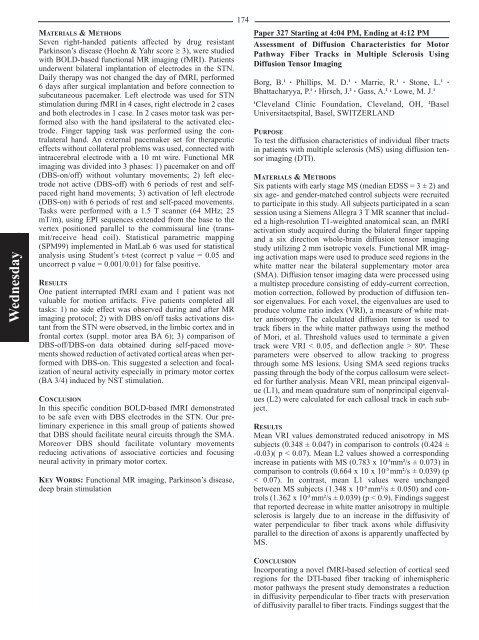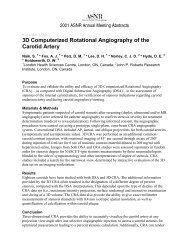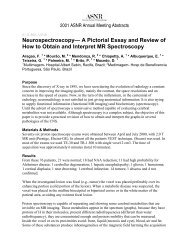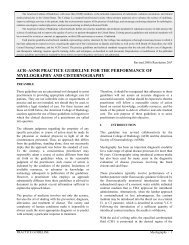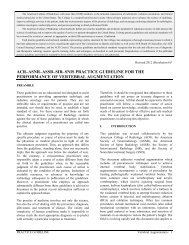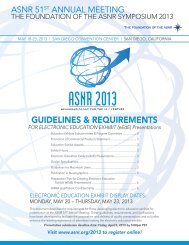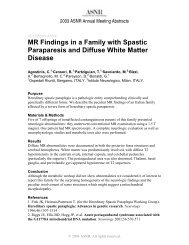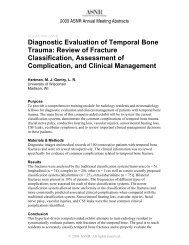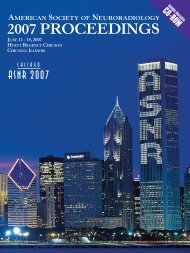2005 Proceedings - ASNR
2005 Proceedings - ASNR
2005 Proceedings - ASNR
Create successful ePaper yourself
Turn your PDF publications into a flip-book with our unique Google optimized e-Paper software.
Wednesday<br />
MATERIALS & METHODS<br />
Seven right-handed patients affected by drug resistant<br />
Parkinson’s disease (Hoehn & Yahr score ≥ 3), were studied<br />
with BOLD-based functional MR imaging (fMRI). Patients<br />
underwent bilateral implantation of electrodes in the STN.<br />
Daily therapy was not changed the day of fMRI, performed<br />
6 days after surgical implantation and before connection to<br />
subcutaneous pacemaker. Left electrode was used for STN<br />
stimulation during fMRI in 4 cases, right electrode in 2 cases<br />
and both electrodes in 1 case. In 2 cases motor task was performed<br />
also with the hand ipsilateral to the activated electrode.<br />
Finger tapping task was performed using the contralateral<br />
hand. An external pacemaker set for therapeutic<br />
effects without collateral problems was used, connected with<br />
intracerebral electrode with a 10 mt wire. Functional MR<br />
imaging was divided into 3 phases: 1) pacemaker on and off<br />
(DBS-on/off) without voluntary movements; 2) left electrode<br />
not active (DBS-off) with 6 periods of rest and selfpaced<br />
right hand movements; 3) activation of left electrode<br />
(DBS-on) with 6 periods of rest and self-paced movements.<br />
Tasks were performed with a 1.5 T scanner (64 MHz; 25<br />
mT/m), using EPI sequences extended from the base to the<br />
vertex positioned parallel to the commissural line (transmit/receive<br />
head coil). Statistical parametric mapping<br />
(SPM99) implemented in MatLab 6 was used for statistical<br />
analysis using Student’s t-test (correct p value = 0.05 and<br />
uncorrect p value = 0.001/0.01) for false positive.<br />
RESULTS<br />
One patient interrupted fMRI exam and 1 patient was not<br />
valuable for motion artifacts. Five patients completed all<br />
tasks: 1) no side effect was observed during and after MR<br />
imaging protocol; 2) with DBS on/off tasks activations distant<br />
from the STN were observed, in the limbic cortex and in<br />
frontal cortex (suppl. motor area BA 6); 3) comparison of<br />
DBS-off/DBS-on data obtained during self-paced movements<br />
showed reduction of activated cortical areas when performed<br />
with DBS-on. This suggested a selection and focalization<br />
of neural activity especially in primary motor cortex<br />
(BA 3/4) induced by NST stimulation.<br />
CONCLUSION<br />
In this specific condition BOLD-based fMRI demonstrated<br />
to be safe even with DBS electrodes in the STN. Our preliminary<br />
experience in this small group of patients showed<br />
that DBS should facilitate neural circuits through the SMA.<br />
Moreover DBS should facilitate voluntary movements<br />
reducing activations of associative corticies and focusing<br />
neural activity in primary motor cortex.<br />
KEY WORDS: Functional MR imaging, Parkinson’s disease,<br />
deep brain stimulation<br />
174<br />
Paper 327 Starting at 4:04 PM, Ending at 4:12 PM<br />
Assessment of Diffusion Characteristics for Motor<br />
Pathway Fiber Tracks in Multiple Sclerosis Using<br />
Diffusion Tensor Imaging<br />
Borg, B. 1 · Phillips, M. D. 1 · Marrie, R. 1 · Stone, L. 1 ·<br />
Bhattacharyya, P. 1 · Hirsch, J. 2 · Gass, A. 2 · Lowe, M. J. 1<br />
1 2 Cleveland Clinic Foundation, Cleveland, OH, Basel<br />
Universitaetspital, Basel, SWITZERLAND<br />
PURPOSE<br />
To test the diffusion characteristics of individual fiber tracts<br />
in patients with multiple sclerosis (MS) using diffusion tensor<br />
imaging (DTI).<br />
MATERIALS & METHODS<br />
Six patients with early stage MS (median EDSS = 3 ± 2) and<br />
six age- and gender-matched control subjects were recruited<br />
to participate in this study. All subjects participated in a scan<br />
session using a Siemens Allegra 3 T MR scanner that included<br />
a high-resolution T1-weighted anatomical scan, an fMRI<br />
activation study acquired during the bilateral finger tapping<br />
and a six direction whole-brain diffusion tensor imaging<br />
study utilizing 2 mm isotropic voxels. Functional MR imaging<br />
activation maps were used to produce seed regions in the<br />
white matter near the bilateral supplementary motor area<br />
(SMA). Diffusion tensor imaging data were processed using<br />
a multistep procedure consisting of eddy-current correction,<br />
motion correction, followed by production of diffusion tensor<br />
eigenvalues. For each voxel, the eigenvalues are used to<br />
produce volume ratio index (VRI), a measure of white matter<br />
anisotropy. The calculated diffusion tensor is used to<br />
track fibers in the white matter pathways using the method<br />
of Mori, et al. Threshold values used to terminate a given<br />
track were VRI < 0.05, and deflection angle > 80 o . These<br />
parameters were observed to allow tracking to progress<br />
through some MS lesions. Using SMA seed regions tracks<br />
passing through the body of the corpus callosum were selected<br />
for further analysis. Mean VRI, mean principal eigenvalue<br />
(L1), and mean quadrature sum of nonprincipal eigenvalues<br />
(L2) were calculated for each callosal track in each subject.<br />
RESULTS<br />
Mean VRI values demonstrated reduced anisotropy in MS<br />
subjects (0.348 ± 0.047) in comparison to controls (0.424 ±<br />
-0.03)( p < 0.07). Mean L2 values showed a corresponding<br />
increase in patients with MS (0.783 x 10 -3 mm 2 /s ± 0.073) in<br />
comparison to controls (0.664 x 10 x 10 -3 mm 2 /s ± 0.039) (p<br />
< 0.07). In contrast, mean L1 values were unchanged<br />
between MS subjects (1.348 x 10 -3 mm 2 /s ± 0.050) and controls<br />
(1.362 x 10 -3 mm 2 /s ± 0.039) (p < 0.9). Findings suggest<br />
that reported decrease in white matter anisotropy in multiple<br />
sclerosis is largely due to an increase in the diffusivity of<br />
water perpendicular to fiber track axons while diffusivity<br />
parallel to the direction of axons is apparently unaffected by<br />
MS.<br />
CONCLUSION<br />
Incorporating a novel fMRI-based selection of cortical seed<br />
regions for the DTI-based fiber tracking of inhemispheric<br />
motor pathways the present study demonstrates a reduction<br />
in diffusivity perpendicular to fiber tracts with preservation<br />
of diffusivity parallel to fiber tracts. Findings suggest that the


